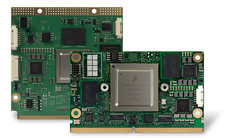congatec launches i.MX 8X on SMARC 2.0 and Qseven modules

The new benchmark for 2 - 4 watt applications
Deggendorf/Munich, Germany, 13 November 2018 * * * congatec – a leading vendor of standardized and customized embedded computer boards and modules – is presenting new versions of its NXP i.MX 8 based SMARC 2.0 and Qseven modules at electronica (Hall B5, Booth 402). The new small form factor modules based on the NXP i.MX 8X extend existing congatec i.MX8 offerings particularly for the area of ultra-low-power and highly reliable industrial applications. With the extremely power efficient ARM Cortex A35 architecture, the i.MX 8X modules offer excellent processing and graphics performance scaling from 2 to 4 cores. Applications for this new 2 - 4 watt class of embedded computer modules with support for the extended temperature range from -40°C to +85°C, domain resource partitioning, and real-time, IEEE 1588 compliant Ethernet support for IoT connected devices can be found in outdoor and mobile vehicle applications as well as in industrial IIoT and Industry 4.0 devices, machines and systems.
“Standardized Computer-on-Modules from congatec offer ARM developers greater design security and easier implementation of the processing core despite increasing complexity. They make OEM designs scalable across the entire i.MX8 processor family even though the NXP i.MX 8 QuadMax and i.MX 8X variants are not pin-compatible,” explains Martin Danzer, Director of Product Management at congatec. “The comprehensive software ecosystem for our application-ready modules as well as customer-specific software services from a single source make it easy for developers to concentrate on developing their applications. This applies even to full-custom designs because with congatec, developers can also opt for a fusion of the module and carrier board.”
The services provided by congatec’s Technical Solution Center for the new SMARC 2.0 and Qseven modules with NXP i.MX 8X processors range from implementing High Assurance Booting (HAB) to authenticate both boot loader and OS image by private and public key cryptography to customer specific BSP adaption and long-term software maintenance for Linux and Android. The service offering further includes the selection of suitable components for carrier boards as well as compliance tests of high-speed signals, thermal simulations, MTBF calculations and debugging services for customer-specific solutions. The goal is to always provide customers with the most efficient and convenient technical support – from requirement engineering to mass production.
The feature set of the NXP i.MX 8X based SMARC 2.0 and Qseven modules
The new SMARC 2.0 and Qseven modules for the extended temperature range from 40°C to + 85°C are equipped with i.MX 8X processors and up to 4 GB ultra-low-power but high bandwidth LPDDR4 memory. The main differences between the 8X variants and the i.MX 8 QuadMax processor based modules amount to the availability of 2 to 4 ARM Cortex-A35 cores instead of ARM Cortex-A53, no ARM Cortex-A72 processors, and 1x instead of 2x M4F MCUs. The result is an overall more energy-efficient feature set with a power consumption of less than 3 watts in normal operation. As far as I/Os are concerned, the processors and modules differ by supporting a maximum of 2 displays, one instead of two PCIe Gen 3.0 lanes, and one instead of two MIPI CSI camera inputs. Otherwise the feature set is largely comparable.
When faced with a choice between Qseven and SMARC 2.0, congatec advises its customers to start new designs with SMARC 2.0, as this form factor enables a higher packing density and more graphics than Qseven. Existing designs or solutions with lower graphic requirements are still well served with Qseven. This also applies to the aspect of long-term availability, because this form factor is still leading in terms of quantities.
SMARC 2.0 and Qseven Computer-on-Modules with the NXP i.MX 8 processors are now available as samples in the below variants; congatec will start series production as soon as NXP does.
| Processor | Cores | DRAM | GPU | GPU Shader |
|---|---|---|---|---|
| i.MX8 8QuadMax | 4x Cortex-53, 2x Cortex-72, 2x Cortex M4F | LPDDR4 / DDR4 | 2x GC7000XSVX | 8 |
| i.MX8 8QuadPlus |
4x Cortex-A53, 1x Cortex-72, 2x Cortex M4F |
LPDDR4 / DDR4 | 2x GC7000Lite/XSVX | 8 |
| i.MX8 8Quad | 4x Cortex-A53, 2x Cortex M4F | LPDDR4 / DDR4 | 2x GC7000Lite/XSVX | 8 |
| i.MX8 8QuadXPlus | 4x Cortex-A35, 1x Cortex M4F | LPDDR4 | 1x GC7000Lite | 4 |
| i.MX8 8DualXPlus | 2x Cortex-A35, 1x Cortex M4F | LPDDR4 | 1x GC7000Lite | 4 |
| i.MX8 8DualX | 2x Cortex-A35, 1x Cortex M4F | LPDDR4 | 1x GC7000UltraLite | 2 |
For the specification and all interfaces of the new conga-SMX8X SMARC 2.0 Computer-on-Module, see: https://www.congatec.com/en/products/smarc/conga-smx8x.html
For the specification and all interfaces of the new conga-QMX8X Qseven Computer-on-Module, see:
https://www.congatec.com/en/products/qseven/conga-qmx8x.html
